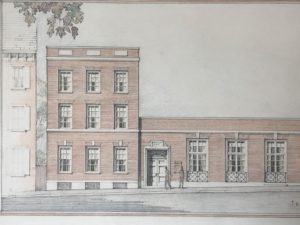In the 1950s, Architect Henry Y. Shaub Introduced Mid-Century Modern to Lancaster
August 21, 2019This is the fourth article in a series focusing on Henry Y. Shaub, an architect who had a lasting impact on Lancaster County.
Architects by nature are innovators as well as problem solvers. Google CEO Eric Schmidt said “…innovators don’t just listen to what people tell them; they actually invent something new, something you didn’t know you needed, but the moment you see it, you say, “I must have it.”

In 1952, architect Henry Y. Shaub sat down with funeral home directors Mr. and Mrs. Robert F. Groff, Sr. and presented two very different design concepts for their proposed new funeral home on West Orange Street. According to their son, Robert F. Groff, Jr., “. . . Mom and Dad were handling half of all the funerals in the city and needed to expand their facilities.” Although funeral home designs were not Shaub’s forte, he took this opportunity to think creatively and help the Groffs reinvent the aesthetic for a building of this type.
Good architects typically present their clients with several options to choose from, with the hope that one will resonate and lead to further refinement. Historically, funeral homes or parlors in the city of Lancaster were housed in either repurposed mansions or in new structures designed in a conservative architectural style such as Colonial Revival. Shaub presented the Groffs with two very different options.

The first was a predictable and attractive three-story, three bay, red brick neo-colonial concept with a one-story annex including an overhead garage door to screen visitor parking from public view. The second concept was an entirely different look for a funeral home and featured a style foreign to the city of Lancaster—mid-century modern. Characterized by a clean aesthetic with an emphasis on rectangular forms, horizontal lines and an absence of decoration, this second concept, which the Groffs selected, turned heads in a city steeped in traditional architecture!
Groff, Jr. recalls that his parents said to Shaub: “. . . make it look like a marble monument and give the funeral home a new look!” The result was a building that stood out in sharp contrast to the surrounding neighborhood and remains one of the few genuine examples of mid-century modern architecture in downtown Lancaster today.
Design Intervention is written by Gregory J. Scott, FAIA, Partner Emeritus
For LNP subscribers, here is the link to the original LNP Article, “In the 1950s, architect Henry Y. Shaub introduced a new style to the city.”